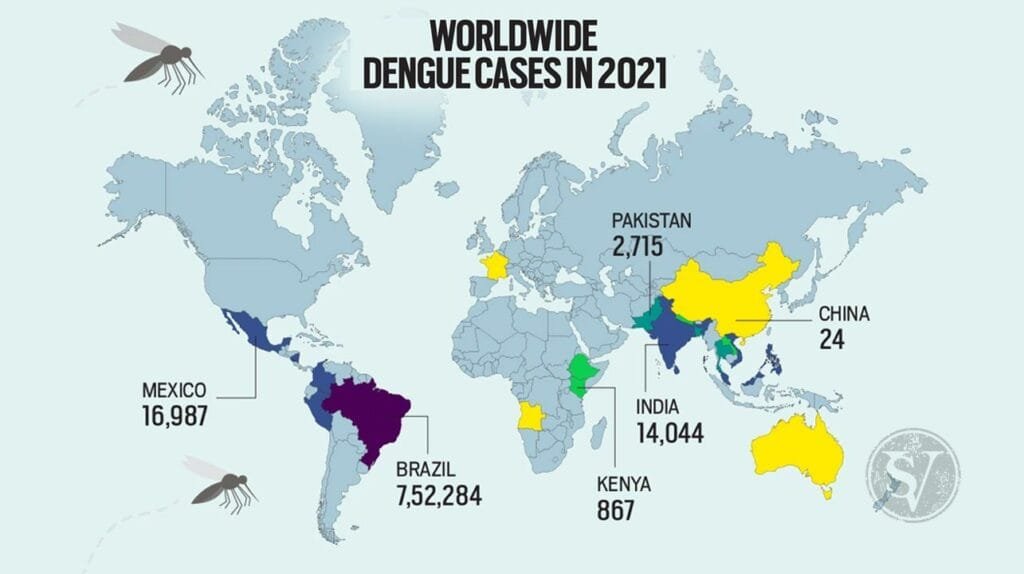Stringent mosquito control needs to be put in place for effective mosquito control.
Dengue Fever Mosquito-Borne viral Disease: How to fight off in Monsoon season
Dengue is a viral infection transmitted to humans through the bite of female mosquitoes. These mosquitoes are also vectors of yellow fever and Zika viruses. It is found in tropical and sub-tropical climate worldwide, mostly in urban and semi-urban areas. Although an estimated 100-400 million infections occur each year, 80% are generally mild and asymptomatic. It is caused by the virus of the Flaviviridae family and there are four distinct, but closely related, serotypes of the virus that cause dengue-
- DENV-1: One of the four serotypes of the firefly born viruses that causes Dengue.
- DENV-2: Preparation of viral particles concentrated from tissue culture supernatant
- DENV-3: This is the recovery phase; it is usually takes a few days for the patients to get back to the normal. At this stage, the patient gains back its appetite, has lower pulse rate, has a convalescent rash at legs and arms.
- DENV-4: Associated with dengue fever and only sporadically associated with serious cases.

Estimate indicates 390 million dengue virus infections per year, of which 96 million manifest clinically.
Types of Dengue fever transmission
- Transfer through mosquito bite
- Human to mosquito transmission
- Maternal transmission
- Other transmission modes (Blood products, organ donation)

Disease Characteristics
Dengue should be suspected when a high fever is accomplished by two of the following symptoms during the febrile phase (2-7 days):
- Swollen tonsils
- Vomiting
- Severe headache
- Rash
- Motion Sickness
Treatment
There is no specific treatment for dengue fever. Patients should rest, stay hydrated and seek medical advice. Supportive care such as fever reducer and pain killers can be taken to control the symptoms of muscle aches and pain. For sever dengue, medical care by physician experienced with the effects and progression of the disease can save lives.
Prevention and Control
At present, the main method to control or prevent the transmission of dengue virus is to fighting the mosquito vectors. This is accomplishing through:
Prevention of mosquito breeding
- Preventing mosquitoes from accessing egg-laying habitats by environmental management and modification
- Disposing of solid waste properly and removing artificial man-made habitats that can hold water
- Covering, emptying and cleaning of domestic water storage containers on a weekly basis
- Applying appropriate insecticides to water storage outdoor containers
Personal protection from mosquito bites
- Using of personal household protection measures, such as window screens, repellents, coils. These measures must be observed during the day both inside and outside of the home (e.g.: at work/school) because the primary mosquito vectors bites throughout the day;
- Wearing clothing that minimizes skin exposure to mosquitoes is advised;
Community engagement
- Educating the community on the risks of mosquito-borne diseases;
- Engaging with the community to improve participation and mobilization for sustained vector control;
Active mosquito and virus surveillance
- Active monitoring and surveillance of vector abundance and species composition should be carried out to determine effectiveness of control interventions;
- Prospectively monitor prevalence of virus in the mosquito population, with active screening of sentinel mosquito collections;
- Vector surveillance can be combined with clinical and environment surveillance.
. According to media quoting health authorities, in 2022 and as of 30 April, 8 278 cases and one death have been reported. This is an increase of 7 878 cases and one death since 21 March 2022.
Also read: Causes of Migraine and Home remedies


